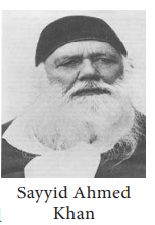Social and Religious Reform Movements in the 19th Century - Islamic Reforms | 10th Social Science : History : Chapter 5 : Social and Religious Reform Movements in the 19th Century
Chapter: 10th Social Science : History : Chapter 5 : Social and Religious Reform Movements in the 19th Century
Islamic Reforms
Islamic Reforms
After the
suppression of great revolt of 1857 Indian Muslims looked to Western culture
with suspicion. The community feared that Western education, Western culture
and Western ideas would endanger their religion. Therefore only a small section
of Muslims accepted the new avenues for modern education.
Sir Sayyid Ahmed Khan
Born in
Delhi into a noble Muslim family, Sayyid Ahmed Khan thought that lack of
education, especially modern education, had harmed the Muslims greatly and kept
them backward. He exhorted the Muslims to accept Western science and take up government
services. He founded a scientific society and translated many English books,
especially science books into Urdu. He believed that the interest of the
Muslims would be best served if they bonded with the British Government rather
than pitch in with the rising nationalist movement. So he advised the Muslims
to take to English education and to concentrate on it.

Aligarh Movement
Sayyid
Ahmed Khan’s movement, the “Aligarh movement,” is so called because it was
centred around the Aligarh Mohammedan Anglo-Oriental college founded by him in
1875, which is a landmark in the history of Indian Muslim education. The college
was raised to the status of a university in 1920.
Deoband Movement
Deoband
was a revivalist movement organized by the orthodox Muslim Ulema. The Ulema
under the leadership of Muhammad QasimWanotavi (1832-80) and Rashid Ahmad
Gangotri (1828 -1905) founded the school at Deoband in the Saharanpur district
of the U.P in 1866. The school curricula shut out English education and western
culture. The instruction imparted was in original Islamic religion and the aim
was moral and religious regeneration of the Muslim community.
Maulana
Mahmud -ul-Hassan became the new Deoband leader. The Jamait-Ul -Ulema (council
of theologians) led by him gave a concrete shape to Hassan’s ideas of
protection of the religious and political rights of the Muslims in the overall
context of Indian unity.
Related Topics